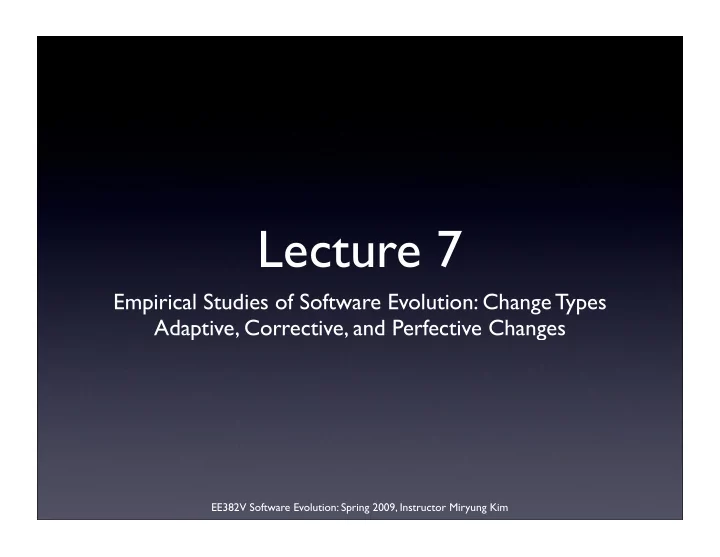

Lecture 7 Empirical Studies of Software Evolution: Change Types Adaptive, Corrective, and Perfective Changes EE382V Software Evolution: Spring 2009, Instructor Miryung Kim
Agenda • Presentation on Kemerer and Slaughter’s paper • Discussion on Kemerer and Slaughter’s paper EE382V Software Evolution: Spring 2009, Instructor Miryung Kim
Change Types • Adaptive changes: add new functionality to a system • Corrective changes: fix faults in the software • Perfective changes: improve developer’s ability to maintain the software without altering functionality or fixing faults EE382V Software Evolution: Spring 2009, Instructor Miryung Kim
Today’s Presenter • Arasi Aravindhan EE382V Software Evolution: Spring 2009, Instructor Miryung Kim
Problem Definition • Identify and understand the phases of software evolution EE382V Software Evolution: Spring 2009, Instructor Miryung Kim
What are the differences between [Eick et al, TSE 2001] and [Kemerer and Slaughter 1999] • Kemerer’s paper focused more on justifying & choosing an approach • Building models that help us understand software evolution • Data sets: abundant, detail data, unique rich data produced by following rigorous process. • quantitative -- statistics, math focused, qualitative EE382V Software Evolution: Spring 2009, Instructor Miryung Kim
Kemerer and Slaughter [TSE, 2001] • It is an *empirical study paper* • No concrete hypotheses. In fact, the goal of this type of research is to identify hypotheses, and to discover a theory of the process of software evolution • Often seen in grounded theory, ethnography, etc. • It is also a survey paper of research methods in studying software evolution. EE382V Software Evolution: Spring 2009, Instructor Miryung Kim
Sideway Discussion: How to write a good survey paper ����� ������ �� ��� � ���������� ���� ������ ����� �� ������ �� ��� �������� �� �������� �������� �� �� ��������� ������� �� ���� �������� ��������� ���� ��� �������� ������� �������� ����� ��� ������� ��� ���� � ����� �� ��� ����� ��� �� ������������ ��� ����� �� ����������� ���������� ��� ������� ���� ��� ����� ������ ��� ��� ������ ������������� ������ ����� ����������� ��������� ���� ���������� ������ �� ������� ��� ����� ������ �� ��� ����� ������� ����������� ������ ����� ������������ ��������� ����������� ��� � ��� �� ����������� ���������� ��� ����� ���� ����� ���� ����� ���������� �������� ��������� ����� �������� �������� ����������� ��������� ��������� ����� ������������ �������� ���� ���� �� ���������� ��� �������������� ������ ��� ������ ��� ������ ��� ���� ������� ����� ���� ������� ��� ��� ��� ������ ����������� �������� �� ����� ����������� ��� ����������� �������� ��� ������ �� ������ ����������� �� ���� ���� �� ������ ��� �� ������� �������� ��� ���������� ������� �� ������� ���� �� ��� ������������ ���� ����� ������ ������� ����� ��������� ���������� ��� �� ����� ��������� ���� ���� ���� => (1) Longitudinal study of (2) rich data from actual, business systems in real organization is required. EE382V Software Evolution: Spring 2009, Instructor Miryung Kim
Study Approach • Data Collection & Data Transformation • Identify Measurement Variables • Analysis • Time Series Analysis • Sequence Analysis • Phase Mapping EE382V Software Evolution: Spring 2009, Instructor Miryung Kim
Study Approach: (1) Data Collection • Some retailer system written in Cobol • Stability of development & management teams • 20 years of data collection • 25000 change log events • module, author, function, date • english description of the change EE382V Software Evolution: Spring 2009, Instructor Miryung Kim
Study Approach: (2) Data Transformation • Three independent coders manually coded change log data using content analytic approach • To maximize inter-rater reliability, • A standard coding procedure was developed. • Several trial data coding processes were performed and Cohen’s K measure improved 0.42 to 0.78. EE382V Software Evolution: Spring 2009, Instructor Miryung Kim
Study Approach: (3)-1 Time Series Analysis • Identification of a quantified, continuous variable: • # of changes per time period • Per year => not sufficient number of time periods • Per week or day => not sufficient number of changes per time period • ARIMA (autoregressive integrated moving average) • Data were not stationary • Data series occurred in a largely random fashion EE382V Software Evolution: Spring 2009, Instructor Miryung Kim
Study Approach: (3)-2 Sequence Analysis used in Social Science • Identification sequences of acts or phases from a long series of categorical data • Phase mapping • group by four consecutive events of the same type • gamma sequence analysis -- Goodman-Kruskal score that assesses the proportion of phase order EE382V Software Evolution: Spring 2009, Instructor Miryung Kim
Results from Sequence Analysis Financial Sales System Manifest Shipping System EE382V Software Evolution: Spring 2009, Instructor Miryung Kim
Results from Sequence Analysis -2 �� ����� ��� ��� ��������� ����� ��������� ������� ��� ����� ��� ��� �������� �������� ������� EE382V Software Evolution: Spring 2009, Instructor Miryung Kim
Threats to Validity • External Validity: Does this work generalize to other situations? • Construct Validity: Was the manual labeling / categorization process reliable and reproducible? Did programmers follow a rigorous data collection procedure? • Conclusion Validity: Would the authors get the same results by grouping events with n consecutive events instead of 4 and by using a different parameter for phase analysis? EE382V Software Evolution: Spring 2009, Instructor Miryung Kim
Any surprising results? • More than 60% were enhancement and perfective changes. • EE382V Software Evolution: Spring 2009, Instructor Miryung Kim
My general thoughts on Kemerer and Slaughter [TSE, 1999] • A highly disciplined qualitative study approach • Attempt to understand software evolution processes from bottom-up using qualitative methods • Nice attempt to incorporate change types • In-depth, longitudinal study of two systems • Results are hard to understand --- It is difficult to find any meaningful conclusions from the phase maps and gamma tables EE382V Software Evolution: Spring 2009, Instructor Miryung Kim
Recommend
More recommend